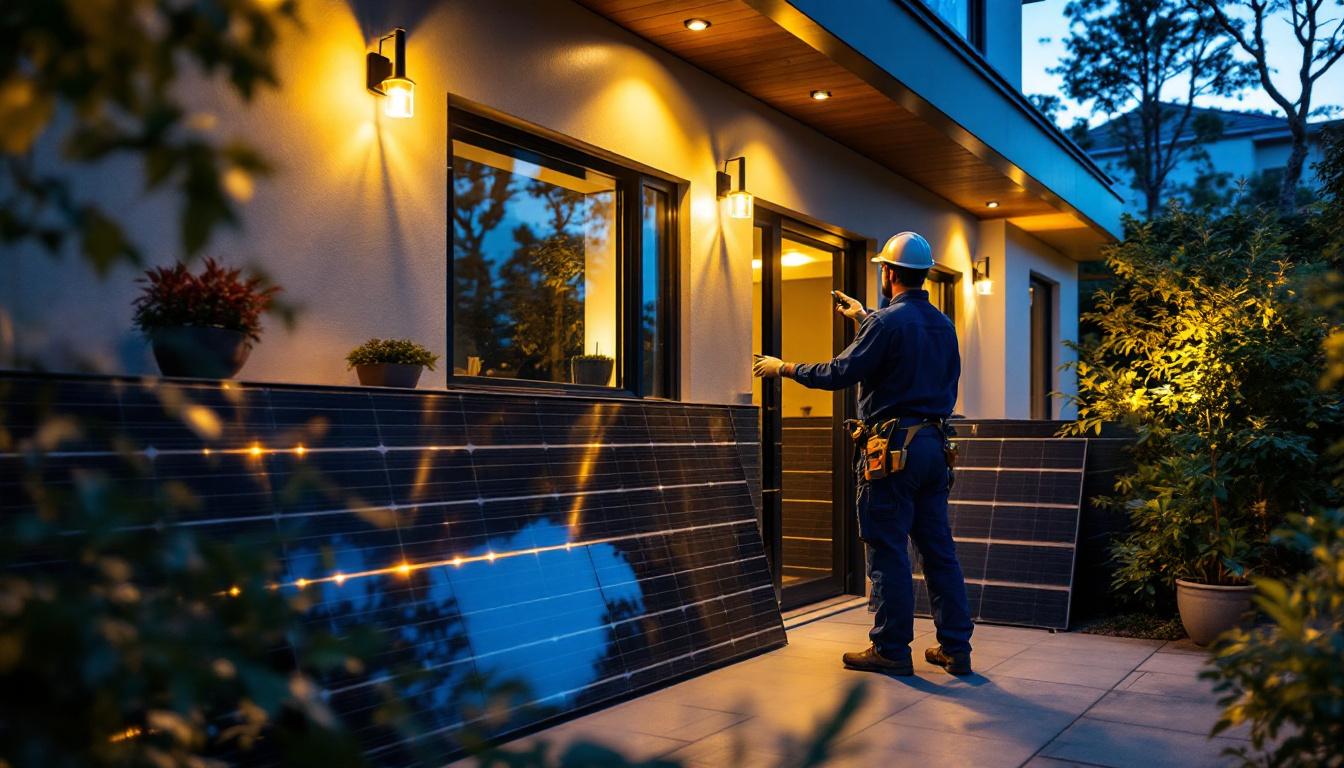
As the demand for sustainable energy solutions continues to rise, lighting contractors are increasingly finding themselves at the forefront of solar panel installations. One innovative approach that has gained traction is the concept of solar panel walls. These installations not only provide energy but also serve as an aesthetic element in modern architecture. This article aims to equip lighting contractors with essential tips and insights to successfully navigate the world of solar panel walls.
Solar panel walls are vertical structures that integrate solar panels into their design, allowing for the generation of electricity while maximizing space efficiency. Unlike traditional solar panel installations, which are often mounted on rooftops, solar panel walls can be incorporated into building facades, offering a dual benefit of energy generation and aesthetic enhancement.
One of the primary advantages of solar panel walls is their ability to harness sunlight in urban environments where roof space may be limited. By utilizing vertical surfaces, these installations can significantly increase the overall energy output of a building. Furthermore, solar panel walls can contribute to energy independence, reducing reliance on grid power and lowering utility costs.
Additionally, solar panel walls can enhance the visual appeal of a building. With various designs and finishes available, contractors can create unique and striking facades that not only serve a functional purpose but also elevate the architectural value of a property. The integration of solar technology into building design also aligns with sustainable practices, making it an attractive option for environmentally conscious developers and homeowners alike.
Moreover, solar panel walls can play a crucial role in improving a building’s energy efficiency. By generating electricity on-site, these structures can reduce the need for traditional energy sources, thereby decreasing greenhouse gas emissions. This is particularly important in densely populated areas where air quality is often compromised. As cities continue to grow, the implementation of solar panel walls can contribute to a more sustainable urban landscape.
When planning a solar panel wall installation, several factors must be taken into account. First and foremost is the orientation of the wall. Ideally, solar panels should face south to capture maximum sunlight throughout the day. However, east and west-facing walls can also be effective, particularly in locations with ample sunlight.
Another important consideration is the structural integrity of the wall. Contractors must ensure that the building can support the weight of the solar panels and associated mounting hardware. This may involve consulting with structural engineers to assess load-bearing capabilities and make necessary modifications. Additionally, the choice of materials for both the solar panels and the wall itself can influence the overall durability and efficiency of the installation. For instance, lightweight materials can minimize the load on the structure while ensuring that the solar panels remain effective over time.
Furthermore, local regulations and building codes may impact the installation process. It’s essential to familiarize oneself with any zoning laws or permits required for solar panel walls, as these can vary significantly by region. Engaging with local authorities early in the planning process can help streamline approvals and ensure compliance with safety standards. This proactive approach not only facilitates a smoother installation but also fosters community support for renewable energy initiatives.
Efficiency is a critical factor in the design of solar panel walls. Lighting contractors should focus on optimizing the layout of solar panels to maximize energy production. This involves not only the arrangement of panels but also the selection of high-efficiency modules that can generate more power from the same amount of sunlight.
When arranging solar panels on a wall, it is essential to consider shading and potential obstructions. Even a small amount of shading can significantly reduce the efficiency of solar panels. Therefore, it is advisable to conduct a thorough site analysis to identify any potential sources of shade, such as nearby trees or adjacent buildings.
In addition to avoiding shading, contractors should also consider the angle of the panels. While vertical installations are common for solar panel walls, tilting panels slightly can enhance their performance by allowing them to capture more sunlight, especially during low-angle sun conditions.
Integrating smart technology into solar panel wall systems can further enhance their efficiency and usability. Smart inverters and monitoring systems can provide real-time data on energy production and consumption, allowing contractors and building owners to optimize their energy usage effectively.
Moreover, the incorporation of battery storage solutions can enable buildings to store excess energy generated during peak sunlight hours for use during the evening or on cloudy days. This not only improves energy efficiency but also contributes to the overall sustainability of the installation.
Before embarking on a solar panel wall project, it is crucial for lighting contractors to familiarize themselves with local regulations and compliance requirements. Different regions may have specific codes governing the installation of solar energy systems, and adherence to these regulations is essential for ensuring a successful project.
The permitting process for solar panel walls can vary significantly depending on the location. Contractors should engage with local authorities early in the planning phase to understand the necessary permits and approvals required for installation. This proactive approach can help avoid delays and ensure that the project proceeds smoothly.
In some cases, contractors may need to provide detailed plans and specifications for the installation, demonstrating compliance with building codes and safety standards. Being well-prepared with documentation can expedite the permitting process and facilitate a successful installation.
Many regions offer incentives and rebates for solar energy installations, which can significantly reduce the overall cost of a solar panel wall project. Lighting contractors should research available programs and inform clients about potential savings. This not only enhances the appeal of solar panel walls but also encourages more clients to consider sustainable energy solutions.
Incentives can come in various forms, including tax credits, grants, and performance-based incentives. Understanding these options can help contractors provide valuable guidance to clients and enhance their service offerings.
Once a solar panel wall installation is complete, ongoing maintenance is essential to ensure optimal performance and longevity. Regular inspections and maintenance can help identify potential issues before they escalate, ensuring that the system operates efficiently over its lifespan.
Conducting routine inspections of solar panel walls is crucial for identifying any signs of wear and tear. This includes checking for dirt and debris accumulation on the panels, which can hinder energy production. Regular cleaning and maintenance can help maximize the efficiency of the system.
Additionally, contractors should inspect the mounting hardware and electrical connections to ensure everything is secure and functioning correctly. Addressing any issues promptly can prevent costly repairs and extend the life of the installation.
As technology continues to evolve, upgrading components of solar panel walls can enhance their efficiency and performance. Lighting contractors should stay informed about advancements in solar technology and be prepared to recommend upgrades to clients when appropriate.
For instance, replacing older solar panels with newer, more efficient models can significantly boost energy production. Similarly, upgrading inverters or adding battery storage systems can enhance the overall functionality of the solar panel wall, providing clients with even greater benefits.
As the market for solar energy solutions expands, effective marketing strategies are essential for lighting contractors to attract clients interested in solar panel walls. Understanding the unique selling points of these installations can help contractors position themselves effectively in a competitive landscape.
One of the most compelling aspects of solar panel walls is their contribution to sustainability. Contractors should emphasize the environmental benefits of solar energy, including reduced carbon emissions and decreased reliance on fossil fuels. By framing solar panel walls as a responsible choice for environmentally conscious consumers, contractors can appeal to a growing demographic of eco-friendly clients.
In addition to environmental benefits, highlighting the long-term cost savings associated with solar panel walls can further entice potential clients. By showcasing case studies or testimonials from satisfied customers, contractors can build trust and credibility in their offerings.
In today’s digital age, leveraging online marketing strategies is crucial for reaching potential clients. Lighting contractors should consider creating informative content, such as blog posts and videos, that educate consumers about the benefits of solar panel walls. This not only positions the contractor as an expert in the field but also enhances visibility in search engine results.
Social media platforms can also be powerful tools for showcasing completed projects and engaging with clients. By sharing high-quality images and success stories, contractors can create a compelling online presence that attracts interest in solar panel wall installations.
As the landscape of energy solutions evolves, lighting contractors have a unique opportunity to lead the charge in the adoption of solar panel walls. By mastering the intricacies of installation, design, compliance, and marketing, contractors can position themselves as experts in this innovative field. With the right knowledge and strategies, the integration of solar panel walls can not only enhance energy efficiency but also elevate the aesthetic appeal of modern architecture.
Embracing this technology not only benefits contractors and their clients but also contributes to a more sustainable future. As the demand for renewable energy solutions continues to grow, lighting contractors who invest in understanding and implementing solar panel walls will undoubtedly find themselves at the forefront of this exciting industry.
Ready to take the lead in solar panel wall installations? At LumenWholesale, we’re here to support your journey with premium, spec-grade lighting products at unbeatable wholesale prices. Our extensive selection is designed to meet the highest industry standards, ensuring you have access to reliable, high-performance lighting for every project. Plus, with free shipping on bulk orders, you can secure the best value without any hidden fees. Elevate your solar panel wall installations with the quality, affordability, and convenience that only LumenWholesale can provide. Take the next step towards a sustainable future and explore our wholesale lighting options today.

Discover how light fixtures for drop ceilings can transform your lighting installation projects.

Discover the often-overlooked aspects of solar LED lights that every lighting contractor should know.

Discover the transformation of outdoor illumination with solar lawn lights.

Discover essential tips and expert insights for lighting contractors on installing big shop ceiling fans.